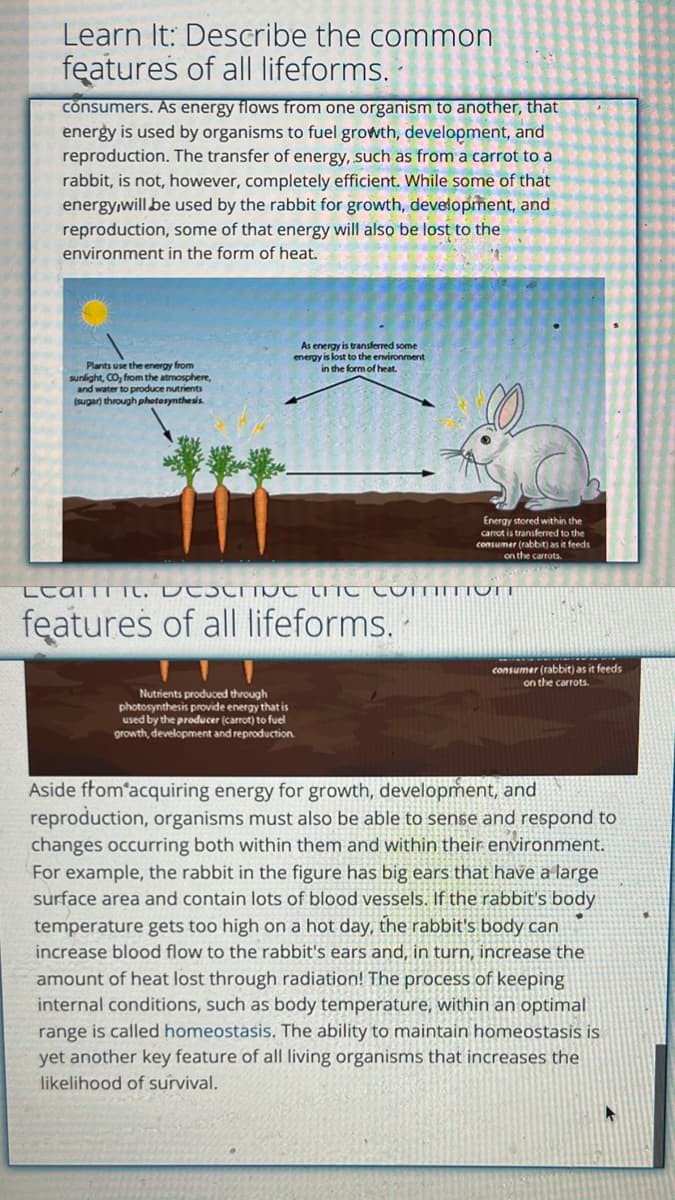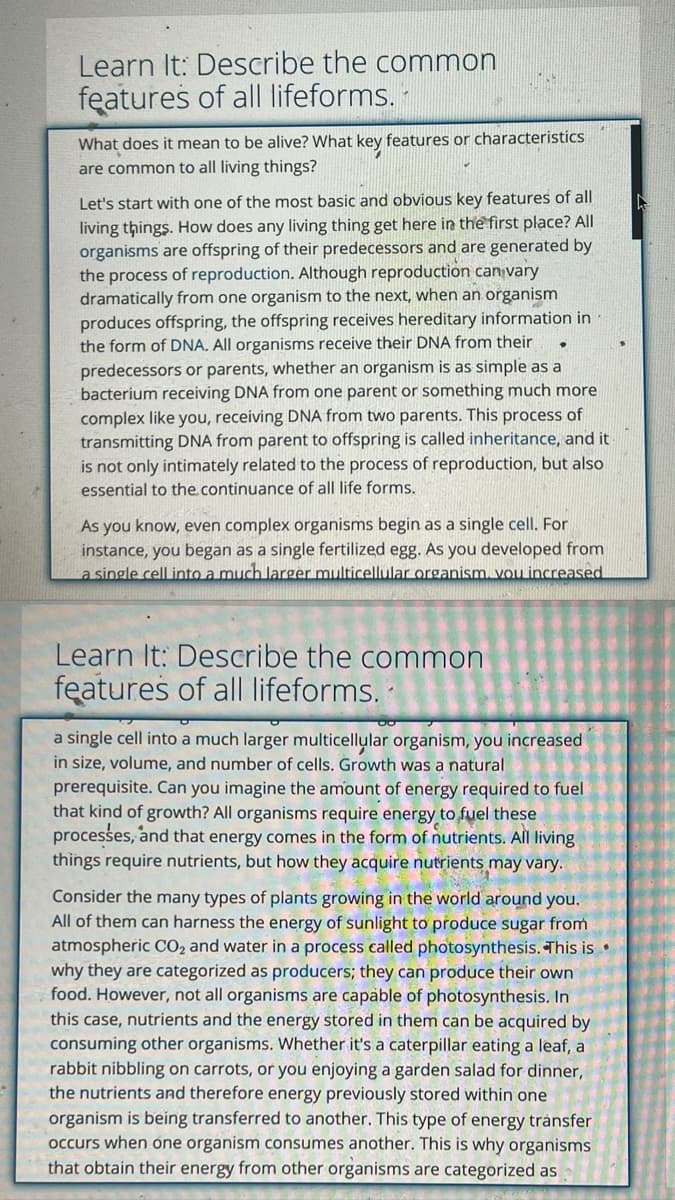hen energy is transferred from one organism to another, some energy is lost to the environment due primarily to ____ ? A.)reproduction B.)growth C.)the release of heat D.)the transmission of DNA
hen energy is transferred from one organism to another, some energy is lost to the environment due primarily to ____ ? A.)reproduction B.)growth C.)the release of heat D.)the transmission of DNA
Biology (MindTap Course List)
11th Edition
ISBN:9781337392938
Author:Eldra Solomon, Charles Martin, Diana W. Martin, Linda R. Berg
Publisher:Eldra Solomon, Charles Martin, Diana W. Martin, Linda R. Berg
Chapter26: Protists
Section: Chapter Questions
Problem 1TYU: Test Your Understanding 1. Which of the following is not true of the protists? (a) they are...
Related questions
Question
When energy is transferred from one organism to another, some energy is lost to the environment due primarily to ____ ?
A.)reproduction
B.)growth
C.)the release of heat
D.)the transmission of DNA

Transcribed Image Text:Learn It: Describe the common
features of all lifeforms.
consumers. As energy flows from one organism to another, that
energy is used by organisms to fuel growth, development, and
reproduction. The transfer of energy, such as from a carrot to a
rabbit, is not, however, completely efficient. While some of that
energy,will be used by the rabbit for growth, development, and
reproduction, some of that energy will also be lost to the
environment in the form of heat.
Plants use the energy from
sunlight, CO₂ from the atmosphere,
and water to produce nutrients
(sugar) through photosynthesis.
As energy is transferred some
energy is lost to the environment
in the form of heat
Energy stored within the
carrot is transferred the
consumer (rabbit) as it feeds
on the carrots.
LCOTTIL, DCOCTIOC TIC COTTTTTTTT
features of all lifeforms.
Nutrients produced through
photosynthesis provide energy that is
used by the producer (carrot) to fuel
growth, development and reproduction.
consumer (rabbit) as it feeds
on the carrots.
Aside from acquiring energy for growth, development, and
reproduction, organisms must also be able to sense and respond to
changes occurring both within them and within their environment.
For example, the rabbit in the figure has big ears that have a large
surface area and contain lots of blood vessels. If the rabbit's body
temperature gets too high on a hot day, the rabbit's body can
increase blood flow to the rabbit's ears and, in turn, increase the
amount of heat lost through radiation! The process of keeping
internal conditions, such as body temperature, within an optimal
range is called homeostasis. The ability to maintain homeostasis is
yet another key feature of all living organisms that increases the
likelihood of survival.

Transcribed Image Text:Learn It: Describe the common
features of all lifeforms.
What does it mean to be alive? What key features or characteristics
are common to all living things?
Let's start with one of the most basic and obvious key features of all
living things. How does any living thing get here in the first place? All
organisms are offspring of their predecessors and are generated by
the process of reproduction. Although reproduction can vary
dramatically from one organism to the next, when an organism
produces offspring, the offspring receives hereditary information in
the form of DNA. All organisms receive their DNA from their
predecessors or parents, whether an organism is as simple as a
bacterium receiving DNA from one parent or something much more
complex like you, receiving DNA from two parents. This process of
transmitting DNA from parent to offspring is called inheritance, and it
is not only intimately related to the process of reproduction, but also
essential to the continuance of all life forms.
.
As you know, even complex organisms begin as a single cell. For
instance, you began as a single fertilized egg. As you developed from
a single cell into a much larger multicellular organism. vou increased
Learn It: Describe the common
features of all lifeforms.
a single cell into a much larger multicellular organism, you increased
in size, volume, and number of cells. Growth was a natural
prerequisite. Can you imagine the amount of energy required to fuel
that kind of growth? All organisms require energy to fuel these
processes, and that energy comes in the form of nutrients. All living
things require nutrients, but how they acquire nutrients may vary.
Consider the many types of plants growing in the world around you.
All of them can harness the energy of sunlight to produce sugar from
atmospheric CO2 and water in a process called photosynthesis. This is
why they are categorized as producers; they can produce their own
food. However, not all organisms are capable of photosynthesis. In
this case, nutrients and the energy stored in them can be acquired by
consuming other organisms. Whether it's a caterpillar eating a leaf, a
rabbit nibbling on carrots, or you enjoying a garden salad for dinner,
the nutrients and therefore energy previously stored within one
organism is being transferred to another. This type of energy transfer
occurs when one organism consumes another. This is why organisms
that obtain their energy from other organisms are categorized as
Expert Solution
This question has been solved!
Explore an expertly crafted, step-by-step solution for a thorough understanding of key concepts.
Step by step
Solved in 4 steps

Knowledge Booster
Learn more about
Need a deep-dive on the concept behind this application? Look no further. Learn more about this topic, biology and related others by exploring similar questions and additional content below.Recommended textbooks for you

Biology (MindTap Course List)
Biology
ISBN:
9781337392938
Author:
Eldra Solomon, Charles Martin, Diana W. Martin, Linda R. Berg
Publisher:
Cengage Learning

Biology 2e
Biology
ISBN:
9781947172517
Author:
Matthew Douglas, Jung Choi, Mary Ann Clark
Publisher:
OpenStax

Human Physiology: From Cells to Systems (MindTap …
Biology
ISBN:
9781285866932
Author:
Lauralee Sherwood
Publisher:
Cengage Learning

Biology (MindTap Course List)
Biology
ISBN:
9781337392938
Author:
Eldra Solomon, Charles Martin, Diana W. Martin, Linda R. Berg
Publisher:
Cengage Learning

Biology 2e
Biology
ISBN:
9781947172517
Author:
Matthew Douglas, Jung Choi, Mary Ann Clark
Publisher:
OpenStax

Human Physiology: From Cells to Systems (MindTap …
Biology
ISBN:
9781285866932
Author:
Lauralee Sherwood
Publisher:
Cengage Learning

Biology Today and Tomorrow without Physiology (Mi…
Biology
ISBN:
9781305117396
Author:
Cecie Starr, Christine Evers, Lisa Starr
Publisher:
Cengage Learning